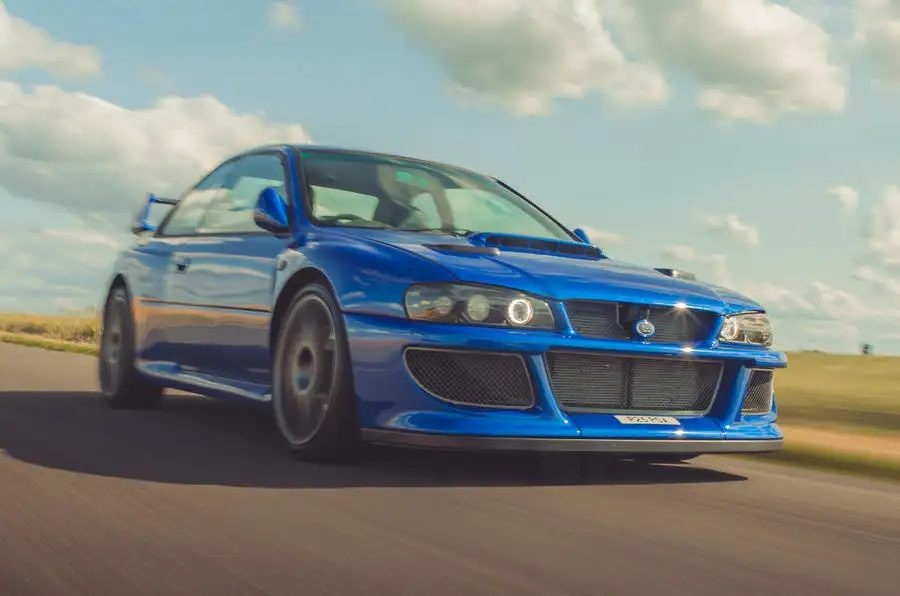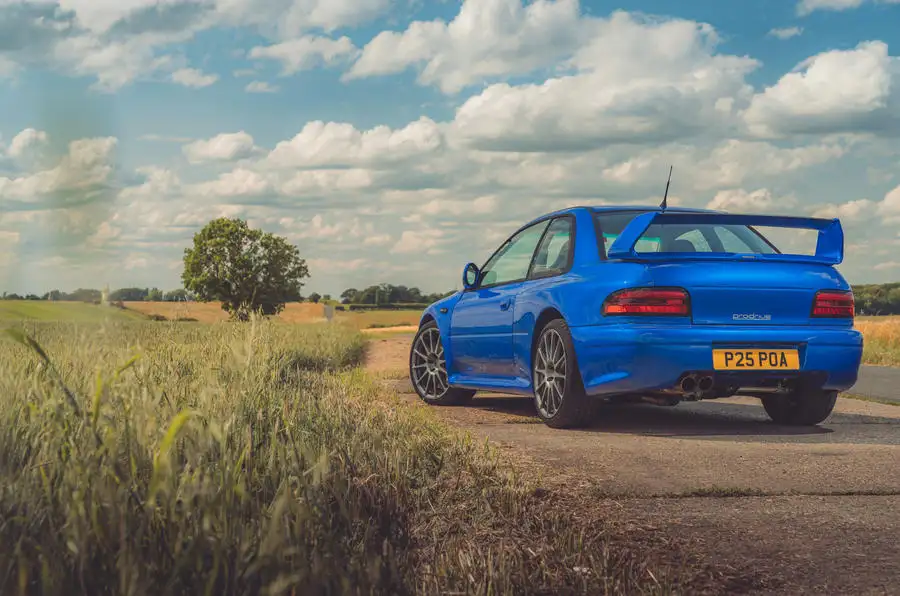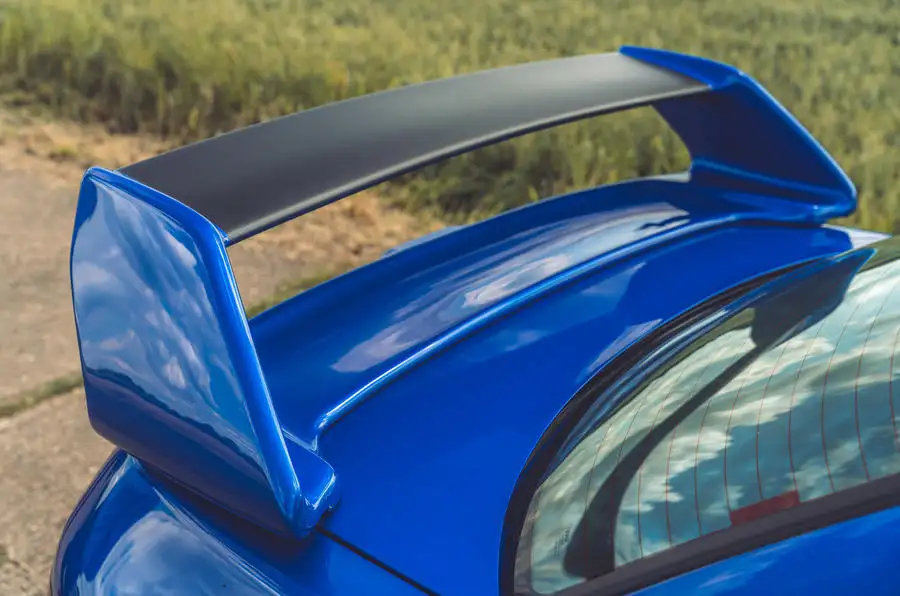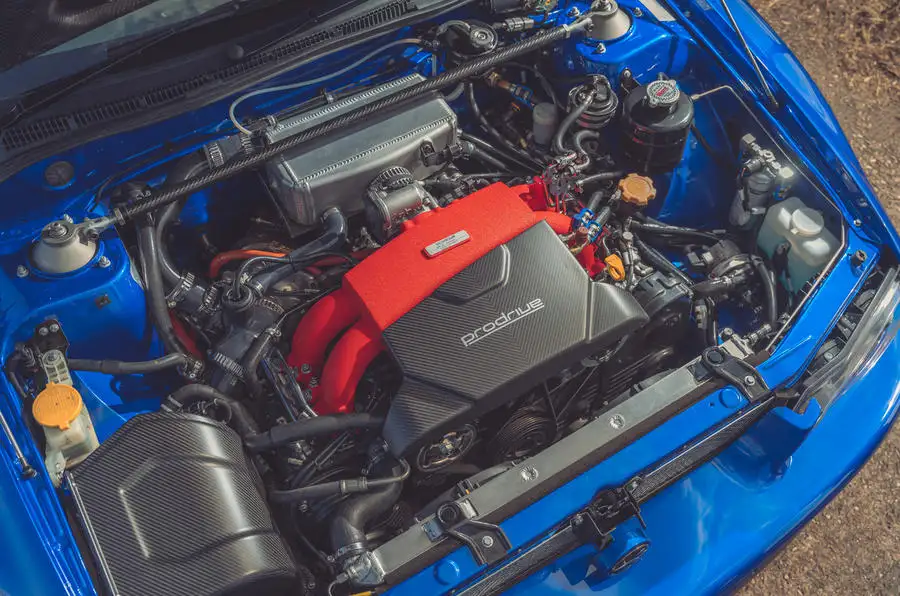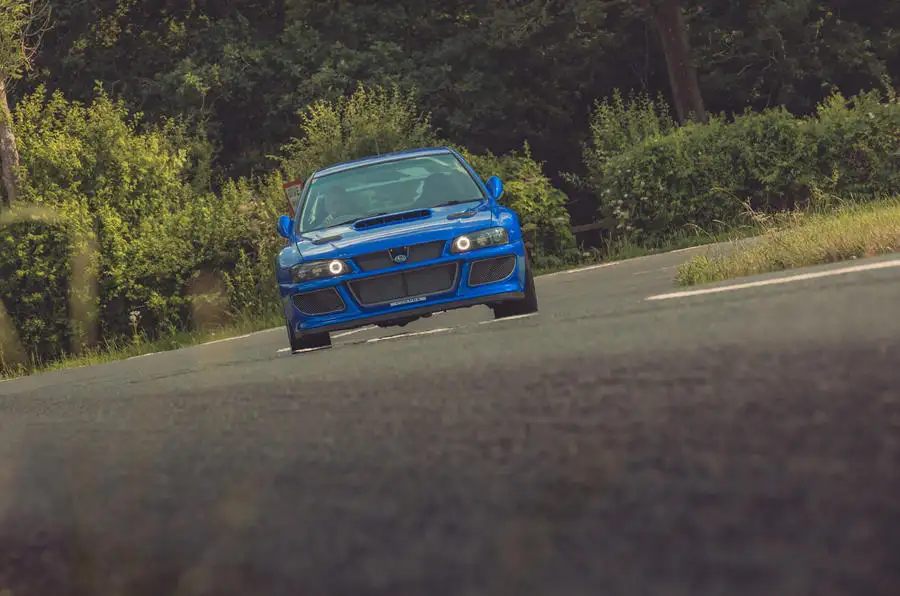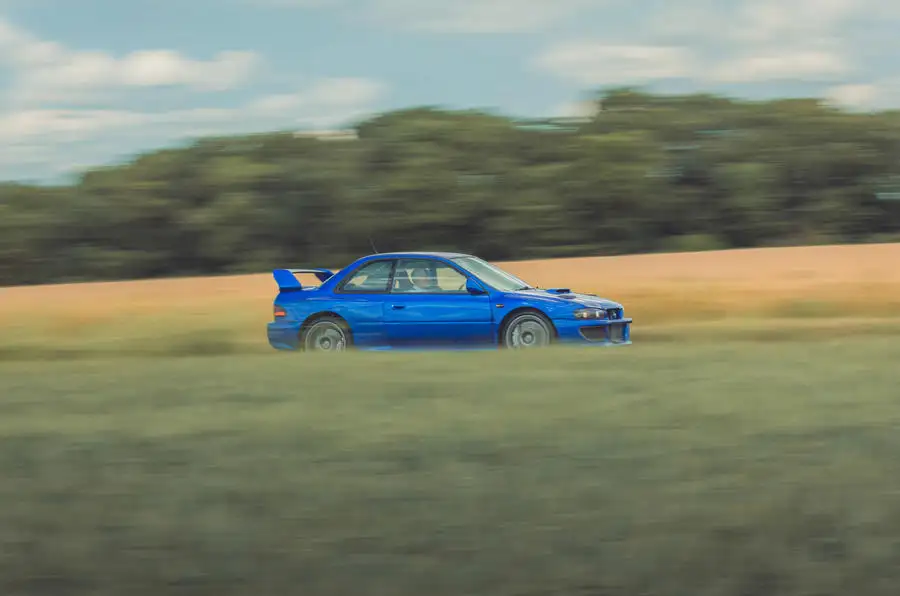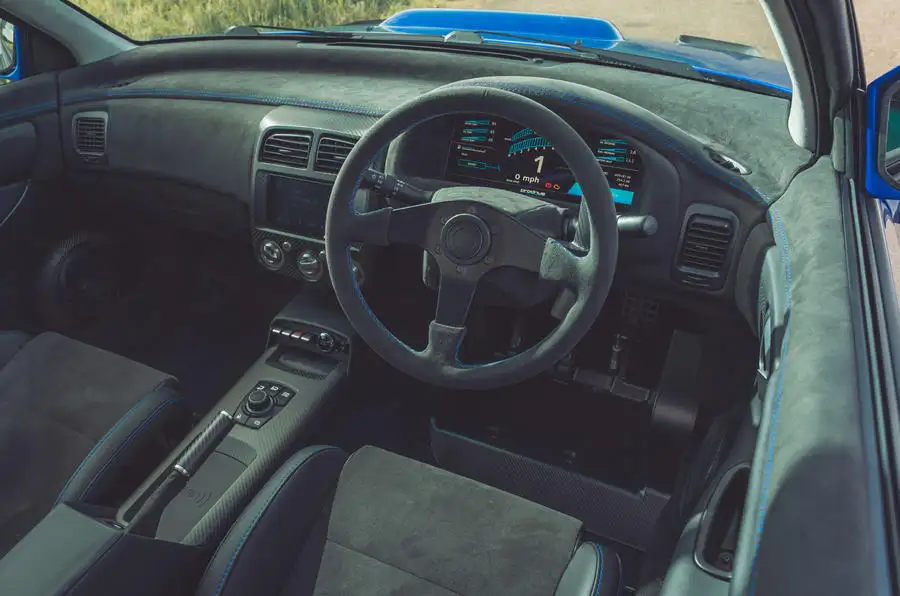Prodrive draws inspiration from Subaru Impreza 22B and World Rally Cars with exclusive road-racer.
A single loud report from a big-bore titanium exhaust announced the Prodrive P25’s arrival.
We had started hearing the growl of an approaching car a little earlier, definitely something with a decent helping of horsepower, but perhaps, we thought, it was some other potent machine, just passing by. However, properly bred rally cars generally produce a characteristic crack, when the engine ignition is cut to facilitate their near-instant gearchanges, and that sound was unmistakable.
Within a minute, front and centre, its exhaust ticking from the heat, stood the final prototype of the P25, a restomod that celebrates the 25th anniversary of the first title success for the Subaru Impreza WRC. And the starting point for that tribute is Subaru’s ultra-rare 1997 Impreza 22B STi. It had been driven on shakedown by Prodrive’s founder and chairman, David Richards, who will soon start delivering cars to customers in earnest. We had arranged to meet for lunch at a welcoming Cotswolds pub called The Fox at Oddington and then take the P25 for a shakedown drive of our own.
About 18 months ago, Banbury-based Prodrive came up with a plan to celebrate its WRC heritage and progress the 22B, itself a commemorative model unveiled at the 1997 Tokyo motor show to mark the 40th anniversary of Subaru and it winning three consecutive World Rally Championship manufacturers’ titles. Only 424 road cars were ever made – of which 400 were for Japan and just 16 for the UK. It’s a matter of legend that it sold out overnight.
When these 22Bs started breaking through the £200,000 (AUD$384,000) auction price barrier, Richards decided to build a new run of 25 “reimagined” road cars, using authentic chassis sourced from UK-imported Impreza WRX models. But this isn’t a restomod of that car: as a tribute to the Prodrive-built Subaru World Rally Cars, the power and performance has been suitably raised.
The plan was to stick close to the philosophy of the original 22Bs while using modern materials, processes and technology to improve everything else: engine, performance, brakes, suspension, quality and interior comfort. There were particular updates for key components such as instrumentation and lighting that have come a very long way in the past 25 years.
Since so few people will ever own a P25, the price was pegged unashamedly high: £460,000 plus taxes, meaning £552,000 (AUD$1.062 million) for UK buyers. You might imagine that such an eye-watering price would limit the P25’s desirability, but not so. Every one has already been sold.
To build a P25, Prodrive prepares and stiffens an authentic Impreza WRX steel monocoque chassis, then dresses everything but the doors with carbonfibre outer panels from its own composites operation in Milton Keynes.
Despite the inclusion of extra equipment and plusher trim to satisfy a modern generation, the new car weighs around 1200kg at the kerb, some 50kg less than the original.
The engine is a Subaru turbocharged flat four, but it’s an updated American-spec 2.5-litre unit (the 22B had a 2.2) with variable valve timing. Prodrive has re-engineered it with new cylinder liners, pistons, conrods, a beefier Garrett turbo and an exotic exhaust system comprising titanium, Inconel and stainless steel.
Prodrive’s engine experts are still calculating the exact power output, but that’s nothing new: nobody was very specific about the 22B’s true output back in the day. The official figure was 203kW, but folklore (and testing) suggests the real figure began with a three.
For the P25, Prodrive claims more than 294kW and 600Nm of torque, thereby promising a power-to-weight ratio of at least 243kW per tonne – nearly 40 per cent more than its predecessor and on a par, thanks to the lightness, with many a 400kW supercar.
This reinforces Prodrive’s case for equipping the P25 with a special, competition-derived, six-speed sequential gearbox, linked to the engine via the company’s own control electronics. Such are the P25’s poke and off-the-line traction that with a conventional synchromesh gearbox on full acceleration, the driver would have to make a first-to-second change less than a second after lift-off or lose time running into the rev limiter.
The quick-shifting dog ’box – which admittedly comes complete with generous amounts of gear whine and off-throttle backlash – incorporates a launch control, selectable on the dash, that gets the P25 off the line at maximum attack and makes the first two changes at full-noise revs (6000rpm) on its own.
All you do is select Launch with a switch on the console, hold the car on the brakes with the accelerator flat and then let it go. The P25 erupts very little wheelspin, its traction and gearchange points entirely managed by electronics. No piston car has ever delivered a 3.5sec 0-100km/h time with less driver effort.
Taking control of the gearbox is simple, too. Changes are controlled by a big, banana-shaped right-hand shift paddle (pull for up, push for down), and if you pull decisively, they’re instant.
Power reaches all four wheels via a centre differential whose torque split is either actively governed or manually adjustable from the cockpit, rally-style, and there are limited-slip diffs front and rear.
The handsome 19in alloy wheels are shod with fat (235/35) Bridgestone Potenza tyres. Behind them are huge, ventilated AP Racing brakes, and at the insistence of competition drivers who have already driven the car, these are unassisted.
In the pub, we lunched and chatted, but my pork pie was having to give space to butterflies. We had had a little bit of earache from the pub manager about cluttering his car park for photography, but this melted away when he eyeballed the machinery in question. In the flesh, everyone is impressed by the P25’s quiet aura. Sure, it started life as a modest two-door saloon, but its fatter tyres and muscular flanks (80mm wider than standard, front and rear), its blueness and lowness, its gaping cowl scoop and that great big rear wing on the bootlid add up to a presence that’s nothing to do with size.
The P25 is 40mm closer to the road than the standard WRX and has special springs, anti-roll bars and two-way adjustable Bilstein dampers. The wheels are titanium-coloured, rather than the WRC gold of the old days, because Prodrive reckons this distinguishes P25 from replicas. The lack of unnecessary decoration (the only Subaru ID is an elliptical badge in the centre of the new, Peter Stevens-designed nose) also adds to the restraint of the whole car.
Thumb the starter and the competition-bred noise instantly announces what you’re there for. The engine is smooth, but it becomes more raucous as revs rise, getting into proper shouting mode at full throttle beyond 4000rpm. It gets there fast, too, as if there’s no flywheel. Keep it percolating between 3500rpm and the 6000rpm redline and it will give off its exalted best.
As if you need them, you have Boost and Anti-lag buttons on the centre console, as rally cars do. Richards reckons this “turns the turbo into a gas turbine” – one good reason why the exhaust needs its component of heat-resistant Inconel.
Dominating everything is the gearbox. For extreme starts, you can use the launch control that slingshots you to 80mph with amazing ease but a din that sounds extremely professional. Richard Burns was here.
There’s a nice radio in the rather exquisitely trimmed, leather and Alcantara interior (with its lightweight race seats and beautifully simple screens where the instruments used to be), but we never turned it on, and neither will an owner.
For normal starts, you use the competition-bred twin-plate AP Racing clutch to start. It’s not soft but manageably heavy. Pull the paddle into first (there’s a gear-position indicator in the middle of the digital tachometer dial) and go.
You soon learn to make changes decisively for instant response. Pussyfooting results in hesitation and occasional gigantic bouts of backlash. It’s an education to see how Richards and (later) David Lapworth, Prodrive’s legendary technical director, handle the car. They’re decisive, either on the throttle or off it – the recipe for smooth progress.
What confuses at first is the P25’s low-end torque: it will pull strongly with no sign of road car lag from 2000rpm. But it’s best for the gearbox to keep it turning faster. Warm to that task and you will start emitting those wonderful wap-waah, wap-waah downchanges that for many will justify the entire outlay.
The chassis is magnificent – as grippy as any road user could need and almost utterly devoid of attitude as it grips. The steering wheel is firm and stable in your hands. There’s a hint of cornering roll, just enough, but the car tracks like an arrow, deviating obligingly when asked yet offering brilliant turn-in as the first resort. Want to turn tighter? Just add lock. Need more? Turn again and feel the instant, precise response. In the P25, slip angles don’t seem to apply.
For all its outrageous capability, the car’s creators remain somewhat divided on how its suspension should be tuned. This is still a prototype. Some think the price demands plushness, along with a better-damped throttle for those of us, unused to competition cars, whose every right-foot tremor is transmitted faithfully to the powertrain. For now, the P25 is set up to be driven very decisively, so it’s a challenge for those of us who have been feather-bedded by road car controls that hide our mistakes. Of course, for more than half a million quid, Prodrive will give you the P25 you want.
If I owned this car, I would use it much more than, say, a McLaren. It’s smaller and more agile. Despite the price, you can park it easily. There’s more room on the road, too. And for all its low seating, the all-round visibility is great, courtesy of old-fashioned thin pillars. I would overdose on the post-4000rpm shout of the engine (which makes no promises it can’t deliver) and enjoy the challenge of the gearbox, albeit with a hint of extra throttle damping to cover my indiscretions.
Above all, I would be thinking about driving an important car, a machine that commemorates a golden era of motorsport. Also a car that proves that supercars don’t all have to adopt a particular shape and size. Best of all, however, would be the sense of purpose. As Lapworth said just before we parted company and he drove back to base: “First of all, this car is built to be effective. Sure, it feels good, and sure, it’s impressive. But most of all, it’s effective.”
Why does the P25 exist?
Two things brought the P25 to life: the 25th anniversary of the Impreza 22B’s arrival and the recent jump in the prices of used examples.
Ever the businessman, Prodrive chairman David Richards recognised an unmet demand for a small batch of continuation cars whose rarity and careful re-engineering would justify a stratospheric price.
“Several years ago, I set out to buy a 22B at auction,” said Richards. “I was prepared to go to £125,000 (AUD$240,000), maybe even £140,000 (AUD$270,000), but the car went for much more. Then I had the idea of making some cars that would show how the 22B could have progressed if it had stayed in production, starting with genuine two-door shells. Of course, everyone at Prodrive had a different idea about the spec, so we agreed to get together after a month and flesh it. This car is the result. We’ve finished up with something that’s way faster than a Porsche 911 GT3 RS on the Millbrook [Proving Ground] hill route. We reckoned the project would take a year, but that has expanded to about 18 months. But we will have production cars soon.”
The chief engineer’s view
It takes you some time to get used to the P25’s unearthly noise and learn to manage its gearbox. But when you do, you will notice how brilliantly the chassis and steering set-up mixes unimpeachable traction and stability with jink-as-you-like agility.
Nobody demonstrates this – or justifies its importance – better than David Lapworth, master engineer and Prodrive lifer, who played a massive part in delivering Subaru’s 1990s WRC triumphs.
“To drive a top-class rally car,” he says, “you shouldn’t have to demonstrate great car control all the time. Our job as engineers is to deliver a car that does what the driver needs without drama.
“He wants to turn, so he adds lock. He wants to go faster, so he presses the accelerator. Nothing else.
“Of course, a top-class driver needs good judgement, but he shouldn’t have to waste time fighting the car. That’s how we approached the P25.”
To underscore his philosophy, Lapworth quotes Frank Borman, an aeronautical engineer and fighter pilot who in 1966 spent 14 days in space with Nasa. Talking pilot skill, he said: “A superior pilot uses his superior judgement to avoid situations that require the use of his superior skill.”
This outlook, Lapworth says, should guide anyone who wants to build great cars.




